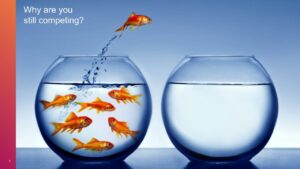By Kevin Norr
Senior Instructional Designer
A well-designed slide can be a fantastic means to present information in a clear, organized, and impactful manner. Too often, however, I’ve seen slides that focus on the presentation’s content at the expense of the audience’s experience. Many presenters make the mistake of assuming that the more information they share—and the more bullet points they add to the slide—the more their audience will learn. In fact, the exact opposite is often true.
When it comes to creating individual slides that will inspire, motivate, and quickly get your message across to your audience, remember the adage less is more. By creating impact slides that feature strong images and minimal text, you can tap into your audience’s experiences and emotions to make your content stick.
What Is an Impact Slide?
An impact slide uses strong, metaphoric imagery and limited text to clearly communicate a concept to the audience. It is designed to inspire or motivate the audience to better understand a particular idea by evoking an emotional reaction, a memory, or a feeling.
 For example, in the slide to the left, you most likely notice the image before the text. The goldfish launching itself into the empty bowl catches our attention because it’s entirely—even humorously—out of the ordinary. The image alone raises a question (Why is it leaping?) and provides the rudimentary elements of a story, which we begin to connect.
For example, in the slide to the left, you most likely notice the image before the text. The goldfish launching itself into the empty bowl catches our attention because it’s entirely—even humorously—out of the ordinary. The image alone raises a question (Why is it leaping?) and provides the rudimentary elements of a story, which we begin to connect.
When paired with the text, this story comes into focus. Our leaping goldfish is through with “competing” and is leaping to the freedom of the spacious, empty bowl where, we imagine, it will be much happier. Note that the text asks a question directly of us, “Why are you still competing?” The inference is obvious: to be happier and more successful, we, like the goldfish, need to stake out new territory.
The Difference a Slide Can Make
As we’ve just seen, an effective impact slide takes the audience on an emotional journey. This experience is a far cry from the more traditional, text-heavy slides that are typically used in presentations. To see the difference an impact slide can make, take a look at the pair of slides below.
Note that both slides focus on how important it is for pharmaceutical sales representatives—the audience in this case—to connect with their customers. However, the slide on the left depends on the text to summarize each of the speaker’s main ideas (imagine a presenter reading each of these bullet points aloud). However, the impact slide on the right focuses on the audience’s experience by providing a compelling image, asking a direct question (How do you truly understand your customer?), and drawing attention to key words through color and font. If paired with a dynamic speaker building on this topic, which slide do you believe would be more compelling to the audience?
5 Tips for Creating Better Impact Slides
- Start With Your Message
 There are 2 key elements of an impact slide: the message and the image. When designing your impact slide, it’s best to start with your message, then select an image that illustrates or supports this message.
There are 2 key elements of an impact slide: the message and the image. When designing your impact slide, it’s best to start with your message, then select an image that illustrates or supports this message.
For example, read the message presented in the slide to the left without its accompanying imagery. To create a message that will have the most impact on your audience:
- Limit your text, but make it effective: Remember, less is more. You want your audience to be able to quickly read the text while focusing primarily on the image. Note the way the message in this example uses bolding to emphasize its key point: the desire “to stand out.”
- Consider addressing your audience directly: To engage your audience and pique their interest, it can be effective to use open-ended questions as well as first person-plural (we) and second-person (you) pronouns, as seen in this example.
- Choose a message that evokes an emotion and creates a connection: For example, the text in this example both unites the audience as a team (What can we do…) and evokes the common desire “to stand out” as unique and successful.
- Identify Strong Images That Convey Meaning
 The image plays a critical role in the impact of your slide. Note how this image, added to our previous message, visually conveys the desire expressed in the text. The blue goldfish is unique—when have you ever seen a blue goldfish? It’s even swimming in the opposite direction from the school of nondescript, run-of-the-mill goldfish. This blue goldfish is the center of our attention and takes up the center of the image. It’s clear that the presenter’s goal is to find a way for their team to stand out from the competition in a similar way.
The image plays a critical role in the impact of your slide. Note how this image, added to our previous message, visually conveys the desire expressed in the text. The blue goldfish is unique—when have you ever seen a blue goldfish? It’s even swimming in the opposite direction from the school of nondescript, run-of-the-mill goldfish. This blue goldfish is the center of our attention and takes up the center of the image. It’s clear that the presenter’s goal is to find a way for their team to stand out from the competition in a similar way.
- Select Images With Backgrounds to Communicate Context
 The background of an image can be used to provide important contextual information. For example, this image doesn’t simply show a doctor who looks stressed. The hospital corridor and medical professionals in the background make it clear that his work is the source of what looks to be a worsening tension headache. This work-related stress, we quickly realize, is the type of “emotion” that may “impact” the “message” to which the text is referring.
The background of an image can be used to provide important contextual information. For example, this image doesn’t simply show a doctor who looks stressed. The hospital corridor and medical professionals in the background make it clear that his work is the source of what looks to be a worsening tension headache. This work-related stress, we quickly realize, is the type of “emotion” that may “impact” the “message” to which the text is referring.
- Select Isolated Images to Focus Attention
 Be aware that, in some cases, background imagery may distract from your message. For example, here, the isolated image set on a plain background narrows our focus and clearly delivers the answer to the question in the text: How easy is it to learn this new software? Answer: It’s a piece of cake. A table full of desserts or an entire cake in the background would only dilute and distract from this message—once again proving that less can be more.
Be aware that, in some cases, background imagery may distract from your message. For example, here, the isolated image set on a plain background narrows our focus and clearly delivers the answer to the question in the text: How easy is it to learn this new software? Answer: It’s a piece of cake. A table full of desserts or an entire cake in the background would only dilute and distract from this message—once again proving that less can be more.
- Use an Image Without Text to Tee Up a Story
 Impact slides can be a great way to introduce a story during your presentation. Instead of giving the story away with a long list of bulleted sentences your audience will immediately read (pulling the attention away from you), select an image that helps you connect the audience to the theme or core message of your story. For example, suppose you wanted to tell a compelling story about the challenges and successes of the first business you ever owned—a lemonade stand. This image might be a great way to leverage nostalgia, garner your audience’s attention, plant the seed for your main idea, and generate empathy.
Impact slides can be a great way to introduce a story during your presentation. Instead of giving the story away with a long list of bulleted sentences your audience will immediately read (pulling the attention away from you), select an image that helps you connect the audience to the theme or core message of your story. For example, suppose you wanted to tell a compelling story about the challenges and successes of the first business you ever owned—a lemonade stand. This image might be a great way to leverage nostalgia, garner your audience’s attention, plant the seed for your main idea, and generate empathy.
It’s important to note that it’s not always possible—or even preferable—to make every slide in a presentation an impact slide. However, when used appropriately, impact slides can inspire and motivate your audience while also improving your ability to convey your message. As you design your next presentation, look for ways to incorporate impact slides to:
- Reinforce important messages
- Highlight points that may not be readily apparent to your audience
- Replace slides that include too much content
- Create opportunities to tell a story
- Generate an emotion or feeling within your audience
Always keep in mind, a well-designed impact slide will have a much greater effect on the audience when delivered by a compelling speaker who can bring the image and text to life. Since your impact slides won’t provide a list of bullet points to read from, take extra time to practice how you’ll present them. It may take a little extra time in the short run, but it will help your presentation have the desired, positive impact on your audience!
____________________________
Kevin Norr is an accomplished education and training professional who brings more than 20 years of experience in designing electronic and in-person courses to Encompass. His experience spans a host of industries, including pharmaceutical sales, aerospace, transportation and shipping, leadership training, financial services, telecommunications, nonprofit organizations, and manufacturing. Kevin earned a PhD in industrial/organizational psychology from Auburn University. He has served part-time as a professor at University of North Carolina Wilmington for over 10 years, creating and teaching online courses in industrial psychology to advanced undergraduate students.




